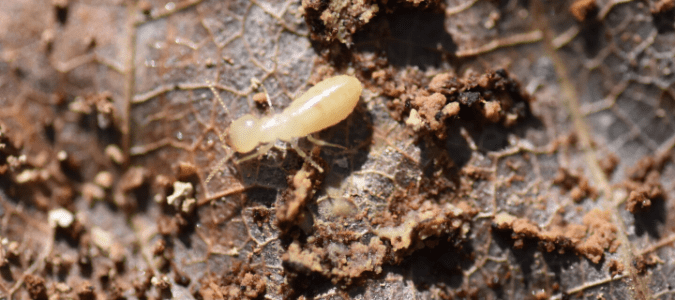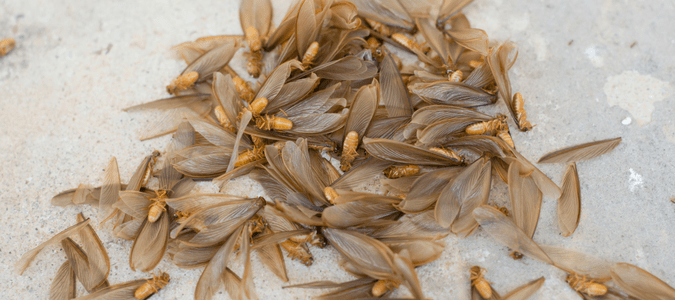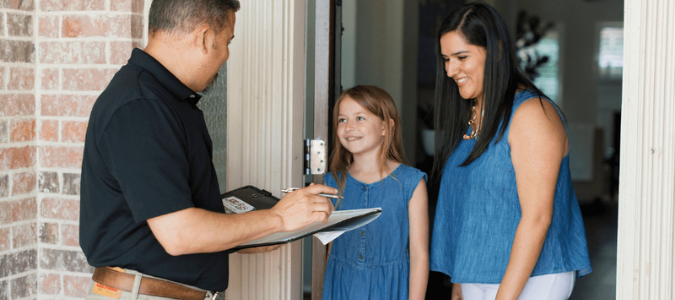If you’ve found white ants in your home, you’re probably wondering what to do. Are they pests that need to be treated? Is there a product you can use to get rid of them? The important thing to understand is that white ants don’t actually exist. If you see what looks like white ants in or near your home, what you’ve actually found is termites.
Different ant species do come in a variety of colors, including red, brown, black and even yellow. There is no such thing as white ants, however. What some people call “white ants” are actually termites. Depending on which type they are, adult termites are either black or white. They do look a lot like ants, and it’s common to confuse the two. Termites need identification and treatment as soon as possible because they can cause major structural damage to your home.
Subterranean termites are the most common type of termite in the U.S. They also cause the most damage to American homes—several billion dollars’ worth, each year. A single subterranean termite colony can number in the hundreds of thousands or even millions. With so many termites actively feeding, it’s easy to see how they can cause a huge amount of damage if left untreated.
All varieties of termites feed on wood. They actually consume the cellulose that’s within wood—the plant fiber that gives wood its structure. There are three types of adult termites: Workers, soldiers and reproductives. The worker termites are the ones that find food and bring it back to feed the colony.
True to their name, subterranean termites build their colonies below the surface of the ground. They build thin tubes out of mud to connect their nests to their food sources. Termite mud nests are often spotted on the foundation of the home or on the support beams of wooden decking.
Worker termites are white because they rarely see the light of day. They live out their lives hidden from view, either underground, traveling through their mud tubes or chewing through the wood their colony needs to survive. If you find “white ants,” or worker termites, it’s most likely because the area where they were hiding was broken open.
This can happen to wood because of the internal damage that termites cause. As they feed on the wood, they create tunnels and chambers inside, weakening its structure. Wood that is badly damaged will needs replacement.
Termites can destroy the wooden framing or siding that make up a home. They can also damage wooden furniture and baseboards as well as decks, fences, attics and other wooden structures.
Common Signs of Termite Activity
If you see what you think are white ants, this is a likely sign of a termite infestation. Here are the other common signs of termite activity nearby:
- Mud tubes—pencil-thin tubes made of mud, often found coming up from the ground on the exterior of a building or deck. These indicate subterranean termite activity.
- Swarmers—the reproductives of the termite colony, which look like flying ants. They swarm out of the nest for a short time in spring, usually after a major rain. They are searching for a mate, so they can lay eggs and found a new colony.
- Discarded wings—these are the termite’s wings that the reproductives shed after mating. People typically find single wings or small piles of them on windowsills, near doors, or near another light source. (This is because the reproductives swarm out of the nest toward light.)
- Frass—drywood termite droppings. Frass looks a lot like sawdust, wood shavings or tiny wood pellets. People typically find small piles of frass near baseboards, on windowsills or beneath wooden furniture that drywood termites are consuming.
- Clicking sounds coming from inside wood—these are the noises that termites make to warn each other when they sense danger. When they feel threatened, they knock their heads against the walls of their tunnels to send warnings to the other termites. These sounds can be hard to hear; sometimes, people notice them only when their pets notice them first.
- Damaged wood—wood that is crumbling away, revealing tunnels and chambers within. This is often caused by termites, but there are other wood-consuming pests that can cause similar damage. A licensed pest control specialist can accurately determine whether you have termites or some other pest, along with the best treatment for the problem.
What to Do When You See a Flying Termite Swarm
Many people confuse termites with flying ants. It’s easy to do: Both insects have black bodies, antennae, and two pairs of wings. It’s important to know whether you’ve seen a flying termite swarm or a group of flying ants. Termites require treatment as soon as possible, so they can’t continue damaging your home. Fortunately, there are a few ways you can tell them apart from ants.
First, termite wings are long and all the same length, whereas flying ants have one shorter pair of wings and one longer one. Ants’ antennae are also bent, while termites have straight antennae—though most people won’t inspect them closely enough to distinguish the shape of their antennae.
Yet another way to know whether you’re dealing with flying ants or termites is to look at their body shapes. Winged ants have three-segmented bodies with distinct, nipped-in “waists,” while termites have thicker “waists.” Their bodies are more straight up and down.
It’s important to note that not all termites have wings. Only the reproductives of the colony have wings, and they only use their wings once, to fly out of the colony in search of a mate. This normally happens in mid- to late spring, and usually after a heavy rain. This is because termites need both warmth and moisture to thrive. When outdoor temperatures start warming up after winter and then spring rains increase the humidity in the air, the conditions are right for swarming.
What Termite Swarming Looks Like
Termite swarmers fly out of the darkness of their colony toward the light, which is why people often see them around windows and exterior doors, or sometimes around light fixtures. Their actual swarming action doesn’t last long—usually less than an hour. The termites have this short period of time to find mates, shed their wings, and make their way to soil. There, they will begin laying eggs and building new colonies.
Sometimes, people see signs in their homes that indicate that a termite swarm happened sometime when they weren’t home to see it. If you find shed wings scattered near a window or door, that could indicate that termites swarmed while you were away.
If you have any reason to think termites have swarmed in your home, it’s time to call in a pest control professional. The same goes for spotting small winged insects if you aren’t sure whether they’re flying ants or termites. Both are pests that require treatment from a professional, but termites need to be addressed as soon as possible. If there is a termite infestation in or near your home, it is actively damaging your valuable property. A reputable termite specialist can make an accurate identification and determine the best plan for treatment.
What Does a Termite Inspection Consist Of?
For many homeowners, suspecting their home might have a termite infestation causes lots of stress. This is understandable since your home is one of your most valuable investments. If you’ve never dealt with termites before, you might wonder what a termite inspection consists of, and how a professional can find and treat a hidden colony.
It’s important to keep in mind that termites cause damage that can be difficult and expensive to fix. Sometimes, termites can cause damage to a home that costs more to fix than the house is worth! The sooner you have a termite problem diagnosed and treated, the better. This is why, if you see any signs of termites in or around your home, it’s time to schedule a termite inspection.
The termite inspector will need to look around the entire perimeter of your house. They will also need to access the attic and garage, and any other structures on the property. If there are any crawl spaces under the home, these are also areas the inspector will need to investigate.
Before your termite inspection starts, it’s a good idea to clear away anything that is blocking any of these areas. This will help the inspector be able to see all areas where termites might be hiding.
When they are inspecting your home, both inside and out, the termite inspector will be looking for any sign of termite activity. This includes mud tubes, damaged wood, termite droppings or signs of a termite swarm. They will also, of course, look for actual, live termites.
The inspector will also look for possible spots where termites might enter your home, such as cracks in your home’s foundation. They will also look for any places where wood touches the ground since these are prime spots for termites to build colonies close to a food source. Your termite inspector may also look for plumbing leaks, since spots where water collects can draw termites and other pests that need the moisture to survive.
A thorough inspection conducted by an experienced termite specialist is one of the best ways for you to protect your home. Termite infestations are not a problem that most people can treat on their own. Hiring a professional for treatment and follow-up inspections is the best way to ensure the pest problem is resolved quickly and completely.
ABC Can Rid Your Home of Termites
Termites are responsible for costing homeowners across the U.S. billions of dollars in property damage. If you believe you may have a termite infestation, contact ABC Home & Commercial Services. We use scientifically proven methods to eliminate these pests, so you can have peace of mind. We also have options for termite control for new construction.



